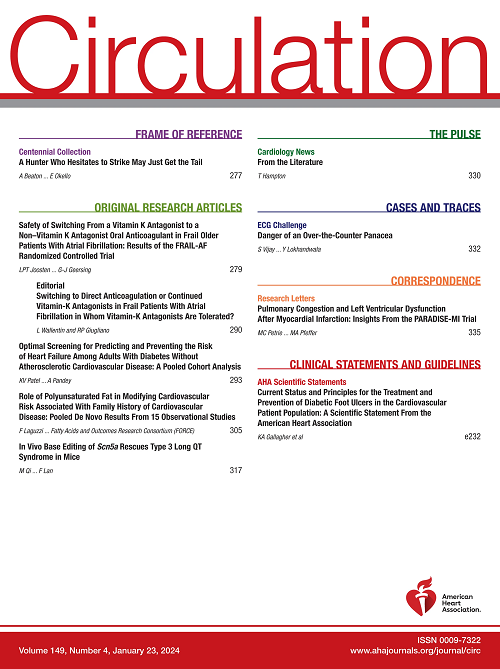Exercise Intolerance and Response to Training in Patients With Postacute Sequelae of SARS-CoV2 (Long COVID): A Scientific Statement From the American Heart Association.
IF 35.5
1区 医学
Q1 CARDIAC & CARDIOVASCULAR SYSTEMS
引用次数: 0
Abstract
The postacute sequelae of SARS-CoV-2, also known as Long COVID, may affect 10% to 25% of individuals diagnosed with SARS-CoV-2. More than 100 symptoms have been reported among patients with Long COVID, but almost all patients report severe fatigue, orthostatic intolerance, shortness of breath, and reductions in exercise tolerance. Emerging data suggest that cardiovascular deconditioning plays a major role in the development of this syndrome and that reductions in functional capacity among patients with Long COVID are comparable to reductions seen among individuals with cardiovascular deconditioning resulting from bed rest. Concern has been raised about the use of exercise training as part of the management strategy for patients with Long COVID. However, exercise training appropriately tailored to the patient with cardiovascular deconditioning may be an effective strategy to facilitate improvement in symptoms. This American Heart Association scientific statement provides a concise yet comprehensive overview of mechanisms contributing to development of Long COVID and methods by which exercise training may be applied to this unique patient population to alleviate symptoms and improve quality of life. In addition, methods of reintroducing exercise and return to play among athletes affected by COVID-19 are discussed.SARS-CoV2 (Long COVID)急性后后遗症患者的运动不耐受和训练反应:美国心脏协会的科学声明
SARS-CoV-2的急性后后遗症,也称为长冠状病毒,可能会影响10%至25%被诊断患有SARS-CoV-2的个体。据报道,长冠肺炎患者有100多种症状,但几乎所有患者都报告严重疲劳、站立不耐受、呼吸短促和运动耐受性降低。新出现的数据表明,心血管疾病在该综合征的发展中起着重要作用,长冠状病毒患者的功能能力下降与卧床休息导致的心血管疾病患者的功能下降相当。人们对将运动训练作为长期COVID患者管理策略的一部分表示担忧。然而,适合心血管疾病患者的运动训练可能是促进症状改善的有效策略。这份美国心脏协会的科学声明提供了一个简洁而全面的概述,概述了促进长COVID发展的机制,以及将运动训练应用于这一独特患者群体以缓解症状和改善生活质量的方法。此外,还讨论了在受COVID-19影响的运动员中重新引入运动和恢复比赛的方法。
本文章由计算机程序翻译,如有差异,请以英文原文为准。
求助全文
约1分钟内获得全文
求助全文
来源期刊

Circulation
医学-外周血管病
CiteScore
45.70
自引率
2.10%
发文量
1473
审稿时长
2 months
期刊介绍:
Circulation is a platform that publishes a diverse range of content related to cardiovascular health and disease. This includes original research manuscripts, review articles, and other contributions spanning observational studies, clinical trials, epidemiology, health services, outcomes studies, and advancements in basic and translational research. The journal serves as a vital resource for professionals and researchers in the field of cardiovascular health, providing a comprehensive platform for disseminating knowledge and fostering advancements in the understanding and management of cardiovascular issues.
 求助内容:
求助内容: 应助结果提醒方式:
应助结果提醒方式:


